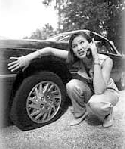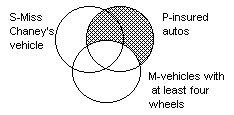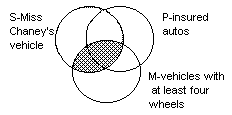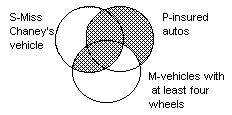|
|
|
Philosophy 103: Introduction to Logic
Syllogistic Terminology, Part II
Continued
from Syllogistic Terminology, Part I |

|
| Abstract: Today's class introduces the logical terms used to describe two premiss
arguments composed of categorical statements. As a stalking horse, we
the second argument and test it for validity by means of Venn Diagrams. |
|
Part
II: Review and Practice with Syllogistic Terminology
- Let us review the foregoing terms
and the procedures by evaluating another argument in summary fashion.
- While Mary Chaney was changing a
flat tire, the car rolled forward off the jack bending the axle. The estimate to fix the
car was $1,580. Mary's car was insured, so she filed a claim. The insurance adjuster said
the claim could not be paid because the vehicle only had three wheels at the time of the
accident and so was not an "auto." An "auto" is defined in the
insurance policy as "a land motor vehicle with at least four wheels designed for use
on public roads." Is the claim adjuster's argument valid?
- We will follows the rules of
thumb described above to analyze the argument.
- First,
find the conclusion. The adjuster concludes, "Miss Chaney's vehicle is not
an insured auto." This is a singular statement and is, in effect, an E
statement because it is universal negative with the subject and predicate undistributed.
Usually singular statements are left as such rather than awkwardly translating into
something like the following:
"No things which are Miss Chaney's vehicle are insured
autos." We will follow the former practice here.
-
Second,
put the syllogism into standard order and form.
- The reasons given for
the conclusion are the statements taken from the insurance adjuster's
claims that an automobile must have at least four wheels and Miss Chaney's didn't.
- The first
premiss, the major premiss, has to have the predicate term of the conclusion. It would be "All insured
autos are land vehicles with at least four wheels.
- The second
premiss, the minor premiss, has the subject term of the conclusion. It would be "Miss Chaney's vehicle
is not a land vehicle with at least four wheels.
In sum, we have the following syllogism:
|
P--MAJOR
TERM |
|
M--MIDDLE
TERM |
| All |
[insured autos] |
are |
[land
vehicles with at least four wheels.] |
|
S--MINOR
TERM |
|
M--MIDDLE
TERM |
| |
[Miss Chaney's vehicle] |
is not |
[a
land vehicle with at least four wheels.] |
|
|
S--MINOR
TERM |
|
P--MAJOR
TERM |
 |
[Miss Chaney's vehicle] |
is not |
[an
insured auto.] |
- A moment's reflection gives us the
following summary of the major parts of the argument and the common terms used to describe
our two-premiss argument. (When analyzing syllogisms, one
usually identifies the terms in the order sequenced
here.)
Categorical syllogism: The
argument contains two premisses and a conclusion, and the argument
contains three terms, each of which is used
twice in the argument.
Conclusion: "Miss
Chaney's vehicle is not an insured auto.
Major term: "insured
autos.
Minor term: "Miss
Chaney's vehicle.
Middle term: "land
vehicles with at least four wheels.
Major premiss: All insured
autos are land vehicles with at least four wheels.
Minor premiss: Miss Chaney's
vehicle is not a land vehicle with at least four wheels.
Mood: AEE
Figure: 2
Form: AEE-2
-
Test the
syllogism for validity. The Venn Diagram representation of the insurance adjuster's argument
could be presented in the following manner.
The form of the syllogism is
All P is M.
No S is M.
No S is P.
|
The major premiss, "All P
is M," by itself can be diagrammed, as before separately. |
 |
|
The minor premiss, "No S
is M," by itself can be diagrammed, separate from the whole, as well. |
 |
|
Putting both diagrams together, if
the syllogism is valid, we ought to be able to read off the conclusion, No S is P."
Especially note that we do not diagram the conclusion. |
 |
- Since the lens area in common
between the S and P classes is completely shaded, we can read off the
conclusion from the completed diagram. The insurance adjuster gave a valid argument. It is
now up to Miss Chaney to question its soundness if she wishes
to pursue her claim. Is there a false premiss in the argument? If so,
even though the argument is valid, the argument does not prove the
conclusion true.
For further practice, try
the Quiz on Syllogistic Terminology.

|
|




